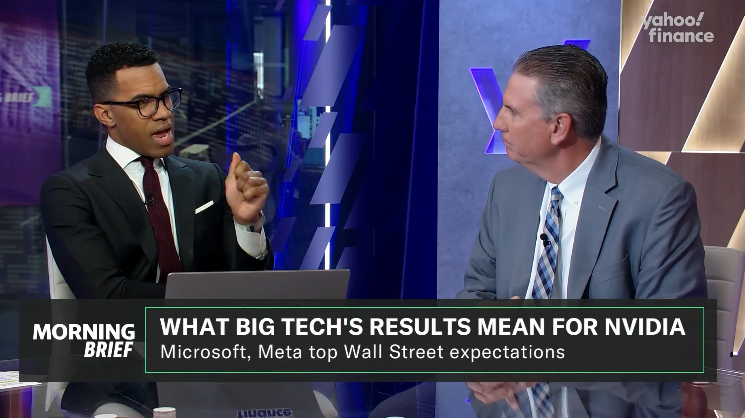
Corporate Earnings Continue to Rise
Market Overview

Sources: Sources for data in tables: Equity Market and Fixed Income returns are from JP Morgan as of 04/20/18. Rates and Economic Calendar Data from Bloomberg as of 04/24/18. International developed markets measured by the MSCI EAFE Index, emerging markets measured by the MSCI EM Index. Sector performance is measured using GICS methodology.
Happening Now
Stocks were able to finish in positive territory last week despite giving back some of the gains earned earlier in the week. In the U.S., the S&P 500 Index improved 0.54% and the Dow Jones Industrial Average gained 0.46%, while the smaller cap Russell 2000 Index outpaced both of its larger counterparts advancing 0.96%. The late week decline may be attributed to investors weighing the incoming corporate earnings releases versus the potential for rising interest rates fueled by positive economic data and slightly hawkish commentary from the Federal Reserve. Speaking of interest rates, the yield on the 10 Year U.S. Treasury finished the week at 2.96% and even breached the 3% mark on Tuesday, a level not seen since 2014.
Investors, and market strategists, now appear to be focusing much of their attention to corporate earnings season. While a broad range of economic and geopolitical factors still exist, such as inflation worries and trade disputes, which may pose a risk to a rise in the equity markets, we are still optimistic that earnings growth and economic expansion will fuel upside stock price potential in the days and months ahead. At the time of this writing, approximately 20% of companies have reported and 81% of those companies have beat analyst estimates. According to Thompson Reuters, if that pace is sustained, it would be the best quarter for U.S. corporate reporting since 1994. The earnings calendar is packed full this week and although there are a number of companies yet to report, including many of the big names in Information Technology such as Apple, Microsoft, and Facebook, investors should be encouraged by the results thus far in this earnings season.
Despite our belief that certain stocks within certain sectors, industries, and geographies will push higher in 2018, we also stress the importance of a well-diversified, global portfolio in line with an investor’s risk/reward tolerance to help protect against potential volatility, as we saw during the 1st quarter of 2018, along the way.
Important Information and Disclaimers
Disclosures: Hennion & Walsh is the sponsor of SmartTrust® Unit Investment Trusts (UITs). For more information on SmartTrust® UITs, please visit www.smarttrustuit.com. The overview above is for informational purposes and is not an offer to sell or a solicitation of an offer to buy any SmartTrust® UITs. Investors should consider the Trust’s investment objective, risks, charges and expenses carefully before investing. The prospectus contains this and other information relevant to an investment in the Trust and investors should read the prospectus carefully before they invest.
Investing in foreign securities presents certain risks not associated with domestic investments, such as currency fluctuation, political and economic instability, and different accounting standards. This may result in greater share price volatility. These risks are heightened in emerging markets.
There are special risks associated with an investment in real estate, including credit risk, interest rate fluctuations and the impact of varied economic conditions. Distributions from REIT investments are taxed at the owner’s tax bracket.
The prices of small company and mid cap stocks are generally more volatile than large company stocks. They often involve higher risks because smaller companies may lack the management expertise, financial resources, product diversification and competitive strengths to endure adverse economic conditions.
Investing in commodities is not suitable for all investors. Exposure to the commodities markets may subject an investment to greater share price volatility than an investment in traditional equity or debt securities. Investments in commodities may be affected by changes in overall market movements, commodity index volatility, changes in interest rates or factors affecting a particular industry or commodity.
Products that invest in commodities may employ more complex strategies which may expose investors to additional risks.
Investing in fixed income securities involves certain risks such as market risk if sold prior to maturity and credit risk especially if investing in high yield bonds, which have lower ratings and are subject to greater volatility. All fixed income investments may be worth less than original cost upon redemption or maturity. Bond Prices fluctuate inversely to changes in interest rates. Therefore, a general rise in interest rates can result in the decline of the value of your investment.
Definitions
MSCI- EAFE: The Morgan Stanley Capital International Europe, Australasia and Far East Index, a free float-adjusted market capitalization index that is designed to measure developed-market equity performance, excluding the United States and Canada.
MSCI-Emerging Markets: The Morgan Stanley Capital International Emerging Market Index, is a free float-adjusted market capitalization index that is designed to measure the performance of global emerging markets of about 25 emerging economies.
Russell 3000: The Russell 3000 measures the performance of the 3000 largest US companies based on total market capitalization and represents about 98% of the investible US Equity market.
ML BOFA US Corp Mstr [Merill Lynch US Corporate Master]: The Merrill Lynch Corporate Master Market Index is a statistical composite tracking the performance of the entire US corporate bond market over time.
ML Muni Master [Merill Lynch US Corporate Master]: The Merrill Lynch Municipal Bond Master Index is a broad measure of the municipal fixed income market.
Investors cannot directly purchase any index.
LIBOR, London Interbank Offered Rate, is the rate of interest at which banks offer to lend money to one another in the wholesale money markets in London.
The Dow Jones Industrial Average is an unweighted index of 30 “blue-chip” industrial U.S. stocks.
The S&P Midcap 400 Index is a capitalization-weighted index measuring the performance of the mid-range sector of the U.S. stock market, and represents approximately 7% of the total market value of U.S. equities. Companies in the Index fall between S&P 500 Index and the S&P SmallCap 600 Index in size: between $1-4 billion.
DJ Equity REIT Index represents all publicly traded real estate investment trusts in the Dow Jones U.S. stock universe classified as Equity REITs according to the S&P Dow Jones Indices REIT Industry Classification Hierarchy. These companies are REITs that primarily own and operate income-producing real estate.



